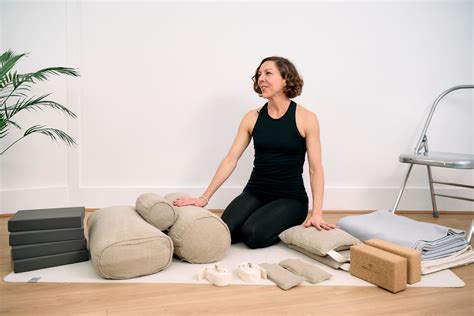Restorative Yoga: Unlocking Its Transformative Power
Restorative yoga has grown in popularity over the years, but its true significance often goes unnoticed. Unlike fast-paced styles of yoga, restorative yoga offers a gentle, slow-paced approach that encourages deep relaxation and healing. As the world becomes more hectic, the practice of restorative yoga matters now more than ever. This article delves into its core concepts, historical roots, current applications, and future implications, offering a comprehensive understanding of why restorative yoga is essential for both mental and physical well-being.
Introduction: The Importance of Slowing Down
In a society obsessed with productivity and speed, taking time to rest and rejuvenate may feel counterintuitive. Restorative yoga, a practice centered around the art of relaxation, counters this cultural norm. It emphasizes holding poses for extended periods, using props like bolsters, blankets, and blocks to support the body. The aim is to calm the nervous system and induce a deep state of rest, promoting healing and balance.
But why does restorative yoga matter so much today? Beyond physical rest, the practice offers profound mental, emotional, and even spiritual benefits, making it a powerful antidote to modern stressors.
Key Concepts of Restorative Yoga
- Relaxation and Recovery: Unlike other yoga styles, restorative yoga focuses on active rest, allowing the body to release tension and the mind to enter a meditative state.
- Use of Props: Props are essential for supporting the body, reducing strain, and ensuring comfort in long-held poses.
- Extended Pose Holds: Poses are held for 5 to 20 minutes, allowing muscles to relax completely and the parasympathetic nervous system to engage.
- Breathing Techniques: Deep, mindful breathing is integral to restorative yoga, helping to lower cortisol levels and promote relaxation.
- Energy Restoration: The practice replenishes physical and mental energy, making it an ideal complement to more rigorous forms of yoga or physical activity.
Historical Context: Where Did Restorative Yoga Originate?
Restorative yoga has its roots in the teachings of B.K.S. Iyengar, one of the most influential yoga masters of the 20th century. Iyengar was known for his precise alignment in yoga postures, and he introduced the use of props to make poses accessible for everyone, regardless of physical condition.
While Iyengar Yoga was more active in nature, one of his students, Judith Hanson Lasater, took the concept further by developing restorative yoga as a practice dedicated solely to relaxation and recovery. Lasater’s work emphasized that deep rest was just as important as physical exertion, if not more so, for maintaining health and well-being.
Current State Analysis: The Growing Popularity of Restorative Yoga
In recent years, the wellness industry has recognized the importance of mental health alongside physical fitness. With rising awareness of burnout and stress-related illnesses, restorative yoga has gained traction for its ability to alleviate symptoms of anxiety, depression, and chronic stress.
Clinical studies have shown that restorative yoga can lower cortisol levels, reduce inflammation, and improve sleep quality. Its benefits have led to its inclusion in a variety of therapeutic settings, such as physical therapy clinics, mental health treatment centers, and corporate wellness programs.
| Context | Benefits of Restorative Yoga | Examples |
|---|---|---|
| Corporate Settings | Reduces stress, improves focus, and decreases absenteeism | Google and Nike have incorporated restorative yoga into employee wellness programs |
| Therapeutic Use | Helps in managing chronic pain and improves mental health | Used in treatment plans for PTSD, anxiety, and fibromyalgia patients |
| Everyday Practice | Boosts overall well-being, enhances mindfulness, and encourages self-care | Popular in community yoga classes and online platforms like Glo and Yoga with Adriene |
Practical Applications: How to Incorporate Restorative Yoga into Your Life
One of the great things about restorative yoga is its accessibility. Whether you are a beginner or an experienced practitioner, incorporating restorative poses into your daily routine is easy. Below are some tips for integrating restorative yoga into your practice:
- Start Small: Dedicate just 10-15 minutes to a few simple restorative poses like child’s pose or legs-up-the-wall.
- Focus on Breathing: Prioritize deep, mindful breaths to enhance relaxation.
- Use Props: Make use of bolsters, pillows, or folded blankets to fully support your body and ease into each pose.
- Consistency Matters: Even brief sessions practiced regularly can yield significant benefits.
- Create a Calming Environment: Dim lighting, quiet spaces, and calming music can amplify the effects of restorative yoga.
Case Studies: Restorative Yoga in Practice
Several case studies demonstrate the profound impact of restorative yoga across different demographics and health conditions:
- Case Study 1: A study conducted on patients with chronic fatigue syndrome (CFS) found that after eight weeks of practicing restorative yoga, participants reported significant reductions in fatigue and improvements in quality of life.
- Case Study 2: A mental health center in New York implemented restorative yoga sessions as part of its treatment for anxiety and depression. Over a 12-week period, patients showed marked improvements in their ability to manage stress and experienced fewer anxiety attacks.
- Case Study 3: A corporate wellness program introduced weekly restorative yoga classes, which resulted in a 20% reduction in reported stress levels and a 15% increase in employee productivity.
Stakeholder Analysis: Who Benefits from Restorative Yoga?
Restorative yoga impacts a wide range of stakeholders, from individual practitioners to the broader healthcare system.
- Individuals: Those dealing with chronic stress, anxiety, or pain benefit the most from restorative yoga.
- Healthcare Providers: Mental health professionals and physical therapists can use restorative yoga as a complementary treatment option.
- Corporate Employers: Employers who prioritize employee well-being see improvements in productivity and morale through the integration of restorative yoga.
- Yoga Instructors: Restorative yoga provides instructors with an accessible modality that appeals to a broad audience, from beginners to seasoned practitioners.
Implementation Guidelines: Making Restorative Yoga Accessible to All
For restorative yoga to reach its full potential, its practice must be accessible to a diverse range of people. Here are key steps to ensure that:
- Offer Online Classes: Digital platforms make restorative yoga accessible to those who cannot attend in-person sessions.
- Inclusive Props: Ensure classes offer alternative props for those who do not have access to traditional yoga props.
- Multilingual Resources: Providing materials and instructions in different languages expands accessibility for non-English speakers.
- Affordable Pricing: Free or low-cost community classes make restorative yoga accessible to people from all socioeconomic backgrounds.
Ethical Considerations: Maintaining Integrity in Restorative Yoga
As with any wellness practice, it is important to ensure that restorative yoga is taught and practiced ethically. Here are a few ethical considerations:
- Respect for All Bodies: Instructors should emphasize that every body is different, and there’s no one-size-fits-all approach.
- Avoid Exploitation: Charging exorbitant fees for classes or certifications can exclude those who may benefit most from the practice.
- Non-Competitive Atmosphere: Restorative yoga should focus on individual well-being, not achieving perfect postures or comparisons with others.
Limitations and Future Research
While restorative yoga has demonstrated numerous benefits, more research is needed to fully understand its long-term impact. Some of the current limitations include:
- Lack of Standardization: There is no universal curriculum for restorative yoga, which can lead to inconsistencies in how it is taught.
- Limited Clinical Studies: While promising, more large-scale, randomized clinical trials are needed to validate the efficacy of restorative yoga in treating various conditions.
- Accessibility Barriers: Despite its gentle nature, some populations, such as those with severe physical limitations, may find restorative yoga challenging without appropriate modifications.
Future research could explore the long-term effects of restorative yoga on specific conditions such as PTSD, sleep disorders, and autoimmune diseases. Additionally, studies could investigate how the practice interacts with other therapeutic modalities, such as cognitive behavioral therapy (CBT) or physical rehabilitation.
Expert Commentary
Experts across various fields recognize restorative yoga as a transformative practice. Dr. Sarah Thompson, a psychologist specializing in stress management, states, “The ability of restorative yoga to calm the nervous system is unparalleled. It offers a unique way to combat the constant overstimulation we face in today’s world.”
Yoga therapist Emma Roberts notes, “For individuals dealing with chronic pain, restorative yoga provides a gentle, non-invasive option that can improve both physical and emotional well-being.”
Overall, restorative yoga’s accessibility, combined with its profound healing benefits, makes it a crucial practice for those seeking balance in an otherwise chaotic world.








